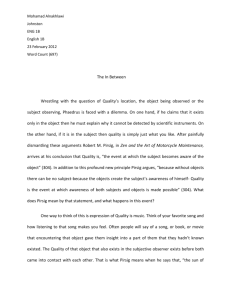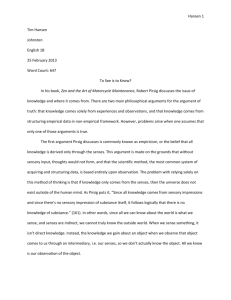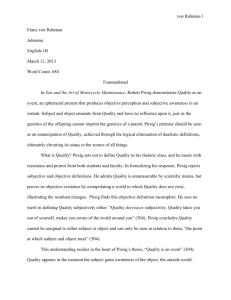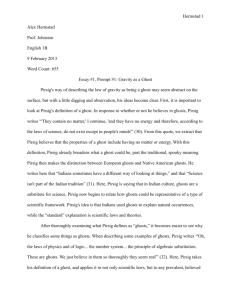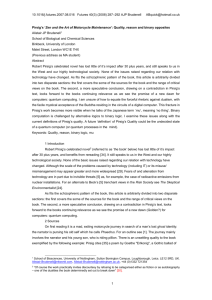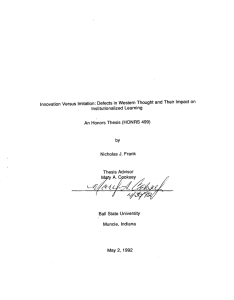Peace of Mind 3
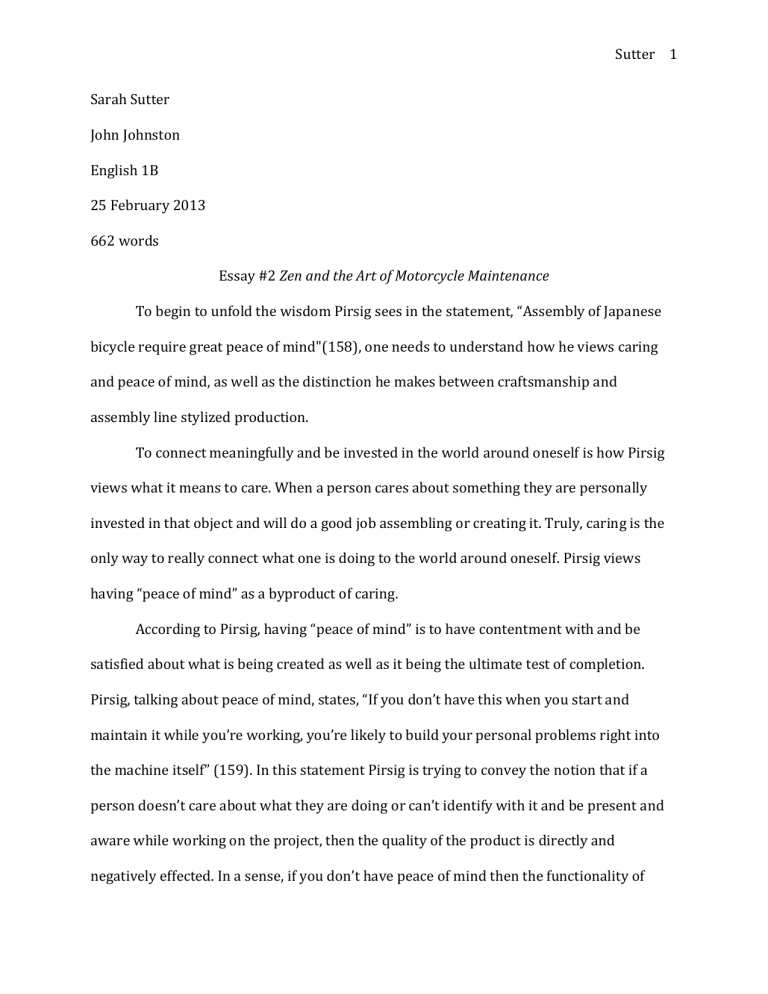
Sutter 1
Sarah Sutter
John Johnston
English 1B
25 February 2013
662 words
Essay #2 Zen and the Art of Motorcycle Maintenance
To begin to unfold the wisdom Pirsig sees in the statement, “Assembly of Japanese bicycle require great peace of mind"(158), one needs to understand how he views caring and peace of mind, as well as the distinction he makes between craftsmanship and assembly line stylized production.
To connect meaningfully and be invested in the world around oneself is how Pirsig views what it means to care. When a person cares about something they are personally invested in that object and will do a good job assembling or creating it. Truly, caring is the only way to really connect what one is doing to the world around oneself. Pirsig views having “peace of mind” as a byproduct of caring.
According to Pirsig, having “peace of mind” is to have contentment with and be satisfied about what is being created as well as it being the ultimate test of completion.
Pirsig, talking about peace of mind, states, “If you don’t have this when you start and maintain it while you’re working, you’re likely to build your personal problems right into the machine itself” (159). In this statement Pirsig is trying to convey the notion that if a person doesn’t care about what they are doing or can’t identify with it and be present and aware while working on the project, then the quality of the product is directly and negatively effected. In a sense, if you don’t have peace of mind then the functionality of
Sutter 2 your assembled product is hindered. Pirsig goes on to say, “The test of the machine is the satisfaction it gives you”(159). Pirsig is saying that when the construction of a machine is created with peace of mind and gives the workman a sense of accomplishment upon completion, it is right and assembled correctly. On the other hand if it is not created with peace of mind then is not correct, even if it is assembled directly according to the instructions.
Pirsig makes a distinction between items made by a craftsman and objects assembled in a production line. Production line work or even items created by a novice workman lack the attention to detail and care of a craftsman. An example of this lack of care happens earlier in the book when Pirsig takes his motorcycle to a mechanic’s shop. He notices the radio is on and the workers are “really slopping things around in a hurry”(26).
Pirsig also comments on their expressions and how, although they seem friendly and mellow, they are also “uninvolved” (26). These men were not invested in their task at hand but rather fulfilling the job just to get paid and then go home. In contrast, a great example of craftsmanship is revealed at the end of chapter 12. Pirsig notices the cabins in the town of
Gardiner. They have perfect moldings and doors that “click shut without looseness” and are, all in all, “just well done” (138). A craftsman created those cabins. They were assembled and built with care, thought and love. The cabins were assembled with “peace of mind”. The craftsman invested himself into those cabins and through this brought meaning into his own life. Pirsig notices this because when a person creates with such deliberateness and intention it is perceptible.
In addition to Pirsig’s feelings about caring and craftsmanship, the fact he saved these particular instructions indicates the level of personal meaning this statement holds
Sutter 3 for him. The ultimate wisdom Pirsig sees in the direction, “Assembly of Japanese bicycle require great peace of mind" (159), has become, for him, a creed to live by. When a person can identify with what they are doing or creating, they are investing their time well. When they are invested in their work they are fulfilled. When they are fulfilled they care about what they are doing. Finally, when a person cares about what they are doing they are really caring about, and for, themselves.
Sutter 4
Works Cited
Pirsig, Robert M. Zen and the Art of Motorcycle Maintenance: An Inquiry into Values.
Toronto: Bantam, 1979. 30-34. Print.
